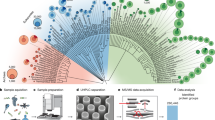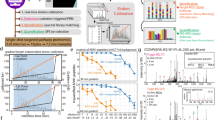Abstract
Experience from different fields of life sciences suggests that accessible, complete reference maps of the components of the system under study are highly beneficial research tools. Examples of such maps include libraries of the spectroscopic properties of molecules, or databases of drug structures in analytical or forensic chemistry. Such maps, and methods to navigate them, constitute reliable assays to probe any sample for the presence and amount of molecules contained in the map. So far, attempts to generate such maps for any proteome have failed to reach complete proteome coverage1,2,3. Here we use a strategy based on high-throughput peptide synthesis and mass spectrometry to generate an almost complete reference map (97% of the genome-predicted proteins) of the Saccharomyces cerevisiae proteome. We generated two versions of this mass-spectrometric map, one supporting discovery-driven (shotgun)3,4 and the other supporting hypothesis-driven (targeted)5,6 proteomic measurements. Together, the two versions of the map constitute a complete set of proteomic assays to support most studies performed with contemporary proteomic technologies. To show the utility of the maps, we applied them to a protein quantitative trait locus (QTL) analysis7, which requires precise measurement of the same set of peptides over a large number of samples. Protein measurements over 78 S. cerevisiae strains revealed a complex relationship between independent genetic loci, influencing the levels of related proteins. Our results suggest that selective pressure favours the acquisition of sets of polymorphisms that adapt protein levels but also maintain the stoichiometry of functionally related pathway members.
This is a preview of subscription content, access via your institution
Access options
Subscribe to this journal
Receive 51 print issues and online access
$199.00 per year
only $3.90 per issue
Buy this article
- Purchase on Springer Link
- Instant access to full article PDF
Prices may be subject to local taxes which are calculated during checkout



Similar content being viewed by others
References
Deutsch, E. W. The PeptideAtlas Project. Methods Mol. Biol. 604, 285–296 (2010)
Ghaemmaghami, S. et al. Global analysis of protein expression in yeast. Nature 425, 737–741 (2003)
de Godoy, L. M. et al. Comprehensive mass-spectrometry-based proteome quantification of haploid versus diploid yeast. Nature 455, 1251–1254 (2008)
Aebersold, R. & Mann, M. Mass spectrometry-based proteomics. Nature 422, 198–207 (2003)
Picotti, P. et al. Full dynamic range proteome analysis of S. cerevisiae by targeted proteomics. Cell 138, 795–806 (2009)
Anderson, L. & Hunter, C. L. Quantitative mass spectrometric multiple reaction monitoring assays for major plasma proteins. Mol. Cell. Proteomics 5, 573–588 (2006)
Foss, E. J. et al. Genetic basis of proteome variation in yeast. Nature Genet. 39, 1369–1375 (2007)
Taussig, M. J. et al. ProteomeBinders: planning a European resource of affinity reagents for analysis of the human proteome. Nature Methods 4, 13–17 (2007); erratum. 4, 187 (2007)
Deutsch, E. W., Lam, H. & Aebersold, R. PeptideAtlas: a resource for target selection for emerging targeted proteomics workflows. EMBO Rep. 9, 429–434 (2008)
Lam, H. & Aebersold, R. Spectral library searching for peptide identification via tandem MS. Methods Mol. Biol. 604, 95–103 (2010)
Lam, H. et al. Building consensus spectral libraries for peptide identification in proteomics. Nature Methods 5, 873–875 (2008)
Craig, R. et al. Using annotated peptide mass spectrum libraries for protein identification. J. Proteome Res. 5, 1843–1849 (2006)
Lange, V. et al. Selected reaction monitoring for quantitative proteomics: a tutorial. Mol. Syst. Biol. 4, 222 (2008)
Lange, V. et al. Targeted quantitative analysis of Streptococcus pyogenes virulence factors by multiple reaction monitoring. Mol. Cell. Proteomics 7, 1489–1500 (2008)
Ahrens, C. H. et al. Generating and navigating proteome maps using mass spectrometry. Nature Rev. Mol. Cell Biol. 11, 789–801 (2010)
Mallick, P. et al. Computational prediction of proteotypic peptides for quantitative proteomics. Nature Biotechnol. 25, 125–131 (2007)
Picotti, P. et al. A database of mass spectrometric assays for the yeast proteome. Nature Methods 5, 913–914 (2008)
Krokhin, O. V. Sequence-specific retention calculator. Algorithm for peptide retention prediction in ion-pair RP-HPLC: application to 300- and 100-A pore size C18 sorbents. Anal. Chem. 78, 7785–7795 (2006)
Craig, R. & Beavis, R. C. TANDEM: matching proteins with tandem mass spectra. Bioinformatics 20, 1466–1467 (2004)
Röst, H., Malmstrom, L. & Aebersold, R. A computational tool to detect and avoid redundancy in selected reaction monitoring. Mol. Cell. Proteomics 11, 540–549 (2012)
Brem, R. B. et al. Genetic dissection of transcriptional regulation in budding yeast. Science 296, 752–755 (2002)
Zuk, O. et al. The mystery of missing heritability: genetic interactions create phantom heritability. Proc. Natl Acad. Sci. USA 109, 1193–1198 (2012)
Michaelson, J. J. et al. Data-driven assessment of eQTL mapping methods. BMC Genomics 11, 502 (2010)
Ackermann, M., Clément-Ziza, M., Michaelson, J. J. & Beyer, A. Teamwork: improved eQTL mapping using combinations of machine learning methods. PLoS ONE 7, e40916 (2012)
Colón, M. et al. Saccharomyces cerevisiae Bat1 and Bat2 aminotransferases have functionally diverged from the ancestral-like Kluyveromyces lactis orthologous enzyme. PLoS ONE 6, e16099 (2011)
Young, E. T. & Pilgrim, D. Isolation and DNA sequence of ADH3, a nuclear gene encoding the mitochondrial isozyme of alcohol dehydrogenase in Saccharomyces cerevisiae. Mol. Cell. Biol. 5, 3024–3034 (1985)
de Smidt, O., du Preez, J. C. & Albertyn, J. Molecular and physiological aspects of alcohol dehydrogenases in the ethanol metabolism of Saccharomyces cerevisiae. FEMS Yeast Res. 12, 33–47 (2012)
Reiter, L. et al. mProphet: automated data processing and statistical validation for large-scale SRM experiments. Nature Methods 8, 430–435 (2011)
Gillet, L. C. et al. Targeted data extraction of the MS/MS spectra generated by data-independent acquisition: a new concept for consistent and accurate proteome analysis. Mol. Cell Proteomics 11, O111–016717 (2012)
Fraser, H. B., Moses, A. M. & Schadt, E. E. Evidence for widespread adaptive evolution of gene expression in budding yeast. Proc. Natl Acad. Sci. USA 107, 2977–2982 (2010)
Acknowledgements
This project has been funded in part by ETH Zurich, the Swiss National Science Foundation (3100A0-107679), the National Heart, Lung and Blood Institute, National Institutes of Health (N01-HV-28179), the National Science Foundation MRI (grant 0923536), the Luxembourg Centre for Systems Biomedicine and the University of Luxembourg, and by SystemsX.ch, the Swiss initiative for systems biology. P.P. is supported by a Foerderungsprofessur grant from the Swiss National Science Foundation (PP00P3_133670), by a European Union Seventh Framework Program Reintegration grant (FP7-PEOPLE-2010-RG-277147) and by a Promedica Stiftung (2-70669-11), H. L. is supported by the University Grant Council of the Hong Kong Special Administrative Region Government, China (HKUST DAG08/09.EG02). A.B. is supported by the Klaus Tschira Foundation and by a European Union FP7 HEALTH grant (HEALTH-F4-2008-223539). R.A. is supported by the European Research Council (ERC-2008-AdG 233226) and by SystemsX.ch, the Swiss Initiative for Systems Biology.
Author information
Authors and Affiliations
Contributions
P.P. and M.C.-Z. carried out the experiments; M.C.-Z., H.L., E.W.D., O.R., L.R., P.P., J.J.M., A.B. and R.A. conceived the data analysis pipeline; P.P., M.C.-Z., H.L., D.S.C., A.S., E.W.D., H.R., Z.S., O.R., L.R., J.J.M. and Q.S. analysed the data; A.S., A.F., Q.S. and U.K. performed mass-spectrometry measurements; P.P., A.B., M.C.-Z., S.A. and R.A. designed the experiments; P.P., M.C.-Z., A.B., H.L., H.R., S.A. and R.A. wrote the manuscript; B.W. and R.L.M. supervised part of the project; and R.A., A.B. and P.P. supervised the project.
Corresponding authors
Ethics declarations
Competing interests
O.R. and L.R. are employees of Biognosys AG, Switzerland.
Supplementary information
Supplementary Information
This file contains a Supplementary Discussion, Supplementary Figures 1-20, Supplementary Text and Data, Supplementary Tables 1-4, Supplementary Methods and additional references. (PDF 3718 kb)
Supplementary Data
This file contains the Supplementary Data used in this study. (XLSX 4758 kb)
Rights and permissions
About this article
Cite this article
Picotti, P., Clément-Ziza, M., Lam, H. et al. A complete mass-spectrometric map of the yeast proteome applied to quantitative trait analysis. Nature 494, 266–270 (2013). https://doi.org/10.1038/nature11835
Received:
Accepted:
Published:
Issue Date:
DOI: https://doi.org/10.1038/nature11835
This article is cited by
-
Generalized precursor prediction boosts identification rates and accuracy in mass spectrometry based proteomics
Communications Biology (2023)
-
Carrying Excess Baggage Can Slowdown Life: Protein Clearance Machineries That Go Awry During Aging and the Relevance of Maintaining Them
Molecular Neurobiology (2022)
-
Generation of a mouse SWATH-MS spectral library to quantify 10148 proteins involved in cell reprogramming
Scientific Data (2021)
-
Peptide barcoding for one-pot evaluation of sequence–function relationships of nanobodies
Scientific Reports (2021)
-
An overview of branched-chain amino acid aminotransferases: functional differences between mitochondrial and cytosolic isozymes in yeast and human
Applied Microbiology and Biotechnology (2021)
Comments
By submitting a comment you agree to abide by our Terms and Community Guidelines. If you find something abusive or that does not comply with our terms or guidelines please flag it as inappropriate.



